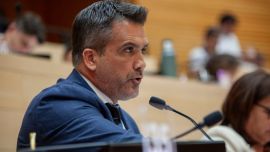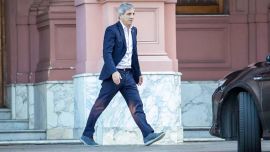No fixed order to this new global series beginning with the international organisations – while the general idea is order of magnitude, an equally important factor defining choice is how newsworthy the organism is for Argentina at this moment in time. Last week’s column on the International Monetary Fund certainly met that criterion – more in the news than ever this week but still writing in sand, so to be continued at a later date.
Today’s subject of Mercosur is definitely the poor cousin among the world’s four main trade blocs (also featuring the European Union, NAFTA and ASEAN) – thus ASEAN’s interchange with China alone tops US$0.5 trillion, equalling Mercosur’s total trade volume. Nevertheless, despite the overwhelming domination of the post-PASO drama involving the IMF & Co., Mercosur has also featured in recent news due to the blaze ravaging the Amazon (evoking issues which far transcend the all-absorbing economic present). The EU-Mercosur trade agreement in principle reached in mid-year (which has yet to be fleshed out with fuller details of market access, never mind ratification by EU members) is already jeopardised by Brazilian President Jair Bolsonaro’s cavalier reactions to this environmental disaster – France’s Emmanuel Macron and Ireland’s Leo Varadkar have been among the loudest voices threatening to vote against the Mercosur trade deal (strange how the vehemence of a country’s reactions here is in direct proportion to the strength of its farming lobbies).
But Brazil, as the very big fly in the ointment, did not begin this month. Mercosur has been lopsided from the start because Brazil bulks so very large – over two-thirds of the bloc’s population even in its broadest definition including the two recent “Bolivarian” recruits (an indefinitely suspended Venezuela and Bolivia whose adhesion still awaits ratification) and 209 million of the 265 million inhabitants of the original quartet (completed by Argentina and the two “guays”), while also accounting for well over 70 percent of the economic output.
Yet such dominance is not unique – the United States accounts for over 90 percent of NAFTA economic output even if only around two-thirds of the population (Mexico rather than Canada explains this discrepancy). Nothing like such preponderance for any one country in the other two majors – Indonesia has less than 40 percent of ASEAN’s population while punching well below its weight and despite all the complaints about Teutonic hegemony, Germany has little over 15 percent of the EU population while its economy accounts for around US$4 trillion or just over 20 percent of the total US$19 trillion.
But the problem with Brazil is not purely numerical although basically related to its size. It might be an exaggeration to talk of “Braxit” but Brazil has been conveying the impression that it has outgrown Mercosur throughout this century and not just now – the South American giant sees the bloc as a regional stepping-stone towards evolving into a world player already dating back to the last century.
But enough of general commentary – let us proceed to this column’s main purpose of providing a basic factsheet for this organisation with reference to Argentina.
* * *
As with the IMF, we will concentrate on history with the present and future so much in the air. And like the IMF (Bretton Woods in mid-1944 and formal creation in late 1945), Mercosur had both a conceptual and an official birth. The conceptual launch was the joint statement in favour of integration signed by Presidents Raúl Alfonsín and José Sarney in late 1985 at the Argentine-Brazilian frontier near the spectacular Iguazú waterfalls. And the formal birth was the Treaty of Asunción signed by Argentina, Brazil, Uruguay and Paraguay in the Easter of 1991.
It was a time when the planets were politically aligned – Argentina, Brazil and Uruguay all shed their military dictatorships between 1983 and 1985 while the treaty hosts were the last on board when the 35-year dictatorship of Alfredo Stroessner ended with his death in 1989. Those were the early days of the Washington Consensus and the “end of history” when everybody believed democracy and the market economy to be mutually reinforcing.
One of Mercosur’s problems is that this political overlap (between Alfonsín and Sarney and later between Carlos Menem and Fernando Henrique Cardoso despite other differences) failed to project itself into this century. Over a decade of centre-left supremacy in both the bloc’s main members – the Argentina of the Kirchners and the Brazil of Lula and Dilma Rousseff – should have ensured continuity but there was no convergence beyond the ideological.
While Lula’s Brazil giving BRICS its first initial and aspiring to a United Nations Security Council seat while hosting the 2014 World Cup and the 2016 Olympics sought a global world role beyond Mercosur, the Kirchners increasingly retreated into a shell of protectionist nationalism. Left-wing enthusiasms also overflowed into creating new regional integration associations like Unasur and ALBA although Mercosur was expanded in this period with the entry of Venezuela in 2006 (only ratified in 2012 thanks to a brief suspension of Paraguay but then suspended itself in 2016) and the adhesion of Bolivia in 2012 (still knocking on the door).
The two main members then shifted right within nine months of each other but just when this trend seemed to be consolidated by Bolsonaro’s inauguration at the start of this year with the outside world seeing the two leaders as virtually twin souls on the same pro-market page (which is a bit hard on poor old President Mauricio Macri), along comes this month’s PASO primary to rock that notion.
Although baptised as Mercosur in 1991, the bloc made its first (and so far only real) advance towards regional economic integration with the Protocol of Ouro Preto in 1994, which established a common external tariff for an internal duty-free area with certain exceptions. Ouro Preto thus defined Mercosur as an imperfect customs union with ambitions to become a common market and it has never really progressed from that phase since, despite such institutional innovations as the establishment of a regional headquarters in Montevideo in 2001 (although nothing to compare with Brussels or Eurocracy) and the creation of a still dormant Parlasur in 2005, which has achieved little beyond adding weight to the Democratic Charter suspending first Paraguay and then Venezuela. Perhaps the biggest lack is any conflict resolution mechanism beyond presidential summits.
No more space but anything missing here can always be picked up in a subsequent column once there is some clarity as to the next government and where it intends to take the EU-Mercosur agreement (not that the answers are all up to Argentina as the Amazon tragedy shows).




















Comments